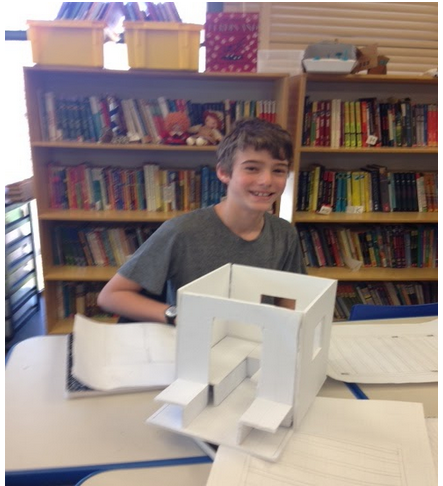The saying, “If you build it, they will come” may have been referring to baseball stadiums, but it may also be the favorite mantra of makerspaces across the country. Since creating our school’s makerspace in November 2013, I’ve seen a small revolution start to grow within our elementary school and also across our district. A makerspace is a learning environment where children can tinker, design and create collaboratively using a variety of materials.
However, a makerspace is so much more than a physical space, it’s a mindset that embraces making as a necessary component of learning. In the past two years, I’ve worked with colleagues to incorporate changes within our curriculum that tap into a child’s natural love of creating.
GETTING STARTED WITH A MAKERSPACE
Our makerspace is a small room off of our library that was once an office and storage space. It is now a vibrant hub of activity, stocked with a variety of high-tech and low-tech supplies that challenge and inspire our little makers. I was fortunate to have been given an old storage room to convert into the physical makerspace; however another challenge persisted and that was, what to put into the space. The ultimate goal for me was to help teachers create new learning experiences that empower the students and incorporate next generation skills.
Having the learning extend beyond the classroom walls and creating vertical curriculum where students teach students is magical when it happens and something I thought could grow out of our makerspace. So it was critical that the items that filled the shelves in our makerspace inspire and facilitate this growth. Staying focused on the idea that, while the 3D printer and coding programs are very cool, it’s truly not about the technology but about transforming teaching and learning experiences for our students.
My love of building and creating actually comes from my own two boys. Watching them create trains, castles, superhero costumes and monster webs out of cardboard and duct tape made me realize that not only were they enjoying a childhood rite of passage when they commandeered the large boxes, but they were applying the 21st Century skills that all educators talk about. They were planning, designing, iterating, collaborating and writing a fantastic story that grew with each step of the process. I needed to bring this love of learning into my classroom and into my school!
Having like minded grade level colleagues and the flexibility to enhance curriculum made it easier to incorporate more hands on project based learning into the 5th grade science units. Rocketry was our first and biggest change as we went from a cookie cutter prescribed way of creating soda bottle rockets to an inquiry based open ended, steeped in design thinking challenge –
this documentary says it all. We also were able to make over our unit on models & designs to incorporate our makerspace and the 3D printer. This also “upped the ante” on our students Rube Goldberg projects as well as their own models designed and printed in school.
MAKING MEANING
Most recently, I revisited the idea of homework and asked my students, “What do you want to learn? How will you learn it? and How will you show what you know?” They are researching, documenting (through writing, sketches, photos and videos), interviewing experts in their field of interest and creating something so meaningful that no testing agency in the world could measure.
Initially, I thought parents might be upset by the absence of traditional homework, however their reaction was the polar opposite. Parents were emailing me stating how proud they were of their child’s efforts and creativity. Many parents even took an active role in this month-long homework assignment that came to be known as The Passion Project.
Ethan taught himself how to use Sketch Up to make a 3D rendering of a fort he wants to build in his backyard. Using foam core he made a model to scale as well as drawings on graph paper. Construction on his 46 sq ft fort begins next week.
Ethan and the scale model of his future fort.
Juliette designed and made her own garden (including the fence). She plans to use the vegetables for cooking and healthy salads. Allie is learning the art of graffiti and even found a local expert to interview and take a lesson with. The list goes on…
Allie’s graffiti inspiration board.
This past year has helped to give our maker movement stronger momentum with the addition of school sponsored clubs (multi-grade makers club and Lego Robotics). These clubs have introduced more students to the space, and encouraged cross grade/school collaborations to incorporate making into the curriculum. And perhaps one of the most ambitious projects of all is our inaugural HExpo(Heathcote Elementary Expo) – our version of a makerfaire.
MAKERFAIRE
The upcoming HExpo is truly going to be a celebration of the positive changes that are happening around our school and district. It’s a celebration of the planning, designing, iterating and collaborating that has grown out of our makerspace and it’s our contribution to the growing maker movement. We have partnered with community members, parents, former students and local businesses and museums to design a series of hands on workshops for students to participate in.
Our impressive line up includes furniture design, architecture, bridge building, 3D design, coding, a mobile planetarium, 3D animation, collage, and several tinker tables for open exploration. Our school’s green club is busy making their version of
Cain’s Arcade for the HExpo.
While the makerspace may be one room in our building, it encompasses a mindset that encourages exploration, imagination and prototyping. This room symbolizes a change where problem solving and creativity are at the core of learning. It’s only one room but the impact is slowly reaching far beyond it’s four walls. HExpo ‘15 will be the first of many to come.

